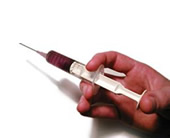-
Bosscher Foundation Live!
The new website is finally live Bosscher Foundation.Read more...
The Active Components In Local Anesthetics
Anesthetics are generally administered with the aim of eliminating the pain experienced during treatment. Thanks to anesthesia, the patient can relax during the treatment, thereby allowing the dentist to concentrate on the procedure in hand. Local anesthetics are seldom, if ever, discussed with the patient. The reason for this rests equally with the dentist as with the patient. For the dentist local, anesthesia is merely a means to an end, i.e. achieving an optimal result with the patient's teeth. The dentist quite often lacks specific knowledge pertaining to the pharmaceutical characteristics of the anesthetic and other active ingredients present in the capsules. A general practitioner, dentist or dental surgeon certainly knows more than enough to administer a local anesthetic, but they are not pharmacists.
Local anesthetics are seldom, if ever, discussed with the patient. The reason for this rests equally with the dentist as with the patient. For the dentist local, anesthesia is merely a means to an end, i.e. achieving an optimal result with the patient's teeth. The dentist quite often lacks specific knowledge pertaining to the pharmaceutical characteristics of the anesthetic and other active ingredients present in the capsules. A general practitioner, dentist or dental surgeon certainly knows more than enough to administer a local anesthetic, but they are not pharmacists.The patient rarely asks for information regarding the use of local anesthetics. This is most often due to a lack of knowledge relating to the subject matter and a (misplaced) reluctance to ask for information.
The patient often does not know that there are several anesthetics available on the market and that each anesthetic has its own advantages as well as disadvantages. The choice is all too often left to the dentist or dental surgeon, not realizing that some anesthetics or other active ingredients can result in unsuspected side effects during, but sometimes also a long time after the treatment. Not daring to bring up this topic of conversation, patients fear that by doing so is a sign of no confidence. Sometimes this fear is not wholly unjustified. Many dentists and dental surgeons speak with patients about the consequences of treatments and the use of materials in a somewhat condescending tone. Quite naturally, this does not foster the ideal climate for the patient to exchange views about the anesthetic to be used during the treatment. Furthermore, the current shortage of dentists means that patients are wary not to upset their dentist. It must be said, however, that the younger generation of dentists reacts in general far more openly to the topic of anesthetics than the older generation. In the absence of specific knowledge concerning local anesthetics, the possibility also exists that difficult questions on this subject are dismissed in a rather nonchalant manner. Respect from and for practitioner as well as patient is essential in such a discussion.
In an attempt to form a basis for your discussion with your dentist or dental surgeon about anesthetics, we have supplied the following explanations about the substances used in local anesthesia.
Most local anesthetics used by general practitioners, dentists and dental surgeons consist of three components.
These are:
1. Anesthetic
2. Vasoconstrictor
3. Preservative
It is important to note that the presence of either vasoconstrictor or preservative in the anesthetic is not necessary for all forms of dental procedures. This will be explained in more detail later.
1. Anesthetic
Substance causing numbness and loss of feeling. The loss of feeling caused by an anesthetic is in principle reversible. Feeling returns after 1 to 1½ hours, somewhat intermittently at first (on touch a "pins-and-needles " feeling) and thereafter a total return of feeling whereby pain resulting from the treatment can be felt. Having foreseen this, your dentist or dental surgeon will instruct you on how best to combat this pain (contact your practitioner in case of doubt).
There are a number of anesthetics used in dental practices in The Netherlands on the market.
Lidocaine Hydrochloride: This substance is found in the anesthetics, Xylocaine™ and Lignocaine™. It is an amide-type anesthetic, was first developed in 1943 and brought onto the market in 1947. Lidocaine is the oldest of the new generation (amide-type) anesthetics. In the past decennia it has been thoroughly tested and compared with other anesthetics, both ester-type and amide-type. One of the disadvantages of lidocaine is that it is slow to take effect. Dentists using lidocaine quite often send their patients back to the waiting room to wait for the anesthetic to take effect. An interim wait in the waiting room is indicative of the use of lidocaine. The advantage of lidocaine is that the product is available without vasoconstrictor (see below) and preservative.
Prilocaine Hydrochloride: Prilocaine is the anesthetic in Citanest™, another amide-type. Citanest™ was developed in 1959 and has been marketed since 1963. Citanest™ is a generally accepted anesthetic in dental practices. According to reports received by the Bosscher Foundation, Citanest™ accounts for more cases of failure to take effect than other anesthetics. This results in a tendency for practitioners to administer an extra high dosage, which in general still does not achieve the desired effect. The cause of this failure to take effect is, as far as we know, still unknown (we reserve judgment pending further information). However, we suspect that inflammation in the body plays a role, even when the inflammation is elsewhere in the body. We would like to receive your experiences with Citanest™.
Articaine Hydrochloride: This anesthetic is one of the most recently developed anesthetics. Articaine hydrochloride was first developed in 1969 and first marketed internationally by Hoechst (now a subsidiary of the Aventis group) in 1976. It was approved for the Dutch market in 1983. This substance was approved for the US market in April 2000 under the name Septanest™ and marketed by Septodont. In The Netherlands, articaine is present in two products, Ultracain™ and Septanest™. In Germany, the product is marketed under the name Ubistesin™. Articaine is an amide-type anesthetic, which, in contrast to other amide-type anesthetics, does not break down in the liver, but in the bloodstream. Articaine is broken down in the bloodstream under the influence of enzymes (cholinesterases). Should the patient have insufficient cholinesterase or should the cholinesterase be dysfunctional, the body seeks alternative methods to break down the articaine. The Bosscher Foundation suspects that by-products are formed during this complimentary or alternative break down of articaine, which can cause and exacerbate a wide range of serious complications.
Mepivacaine Hydrochloride: This product was originally used under the name Scandicaine® for epidural anesthesia in cases of short, local surgical procedures. Mepivacaine has been on the market since 1957. More recently, it was introduced into dental practices under the trade name Scandonest™ 3%. The advantage of this product is that it is available without vasoconstrictor and preservative. Ask your dentist under which circumstances this product can be administered. The Bosscher Foundation believes that the lack of information from patients about this product could stem from the fact that it has not penetrated the Dutch market very deeply.
Procaine: Procaine is an ester-type local anesthetic. It has been available since 1905 and, before the introduction of lidocaine in 1947, the leading anesthetic in dental practices. Procaine is produced under the trade name Novocaine™. Procaine breaks down in the bloodstream just like other ester-type anesthetics. During the break down of this substance, by-products are formed, which can cause allergic reactions. This is one of the biggest disadvantages of ester-type anesthetics. If one ester-type anesthetic causes an allergic reaction then other ester-type anesthetics will most probably also cause an allergic reaction, cross-sensitivity. Cross-sensitivity almost never occurs with amide-type anesthetics.
2. Vasoconstrictor
Vaso=vessel, constrictio=constriction, thus vasoconstrictor=constriction of the blood vessels. In anesthiological terms, a constriction of the blood vessels brought about by the addition of a substance to the anesthetic. The addition of a vasoconstrictor causes a constriction of the blood vessel, which keeps the anesthetic in place longer, preventing it from "leaking away" to other parts of the body. Therefore, the use of a vasoconstrictor means that less of the (toxic) anesthetic is required. It also prevents (post-op) bleeding due to its constrictive effect, which means that procedures can be carried out with less blood loss. The disadvantages of vasoconstrictor usage are possible side effects on the cardiovascular and nervous systems.
Warning: If you suspect that you have a medical condition relating to your cardiovascular system or nervous system, always warn your doctor or dentist, preferably several days before the treatment. Do not wait until being treated.
Vasoconstrictives in Use:
Epinefrine or norepinefrine (a.k.a. adrenaline, noradrenaline) is a hormone (the "fight or flight" hormone) produced in the body, which has an effect of constricting the blood vessels and raising blood pressure. In general doctors are recommended to administer minimum dosages of vasoconstrictor during treatment to prevent possible side effects in the cardiovascular or nervous systems.
Felypressine (octapressine) is a synthetic vasoconstrictor with nearly the same function as epinephrine or norepinefrine, only weaker. As far as we know, felypressine is only used together with prilocaine (Citanest™).
3. Preservatives
If a vasoconstrictor is used in a local anesthetic, it is necessary to protect the vasoconstrictor against oxidization. One of the most common substances is a sulfite compound, but also commonplace is the metylparabene Compound. Listed below are a few preservatives and the anesthetics in which they are used:
sodium sulfite in Ultracain™
methylparabene and metabisulfite In Xylocaine™
sodium metabisulfite in Citanest™
In the above three products, a sulfite compound is used to prevent oxidation of the vasoconstrictor. However, it is known that sulfite compounds can cause allergic reactions. Especially patients with asthmatic bronchitis can react to these compounds. Quite often the reaction is attributed to the anesthetic, yet in reality, this is rarely the case with amide-type anesthetics at least. The preservative is most often responsible for the reaction.

 NL
NL  EN
EN  DE
DE 
